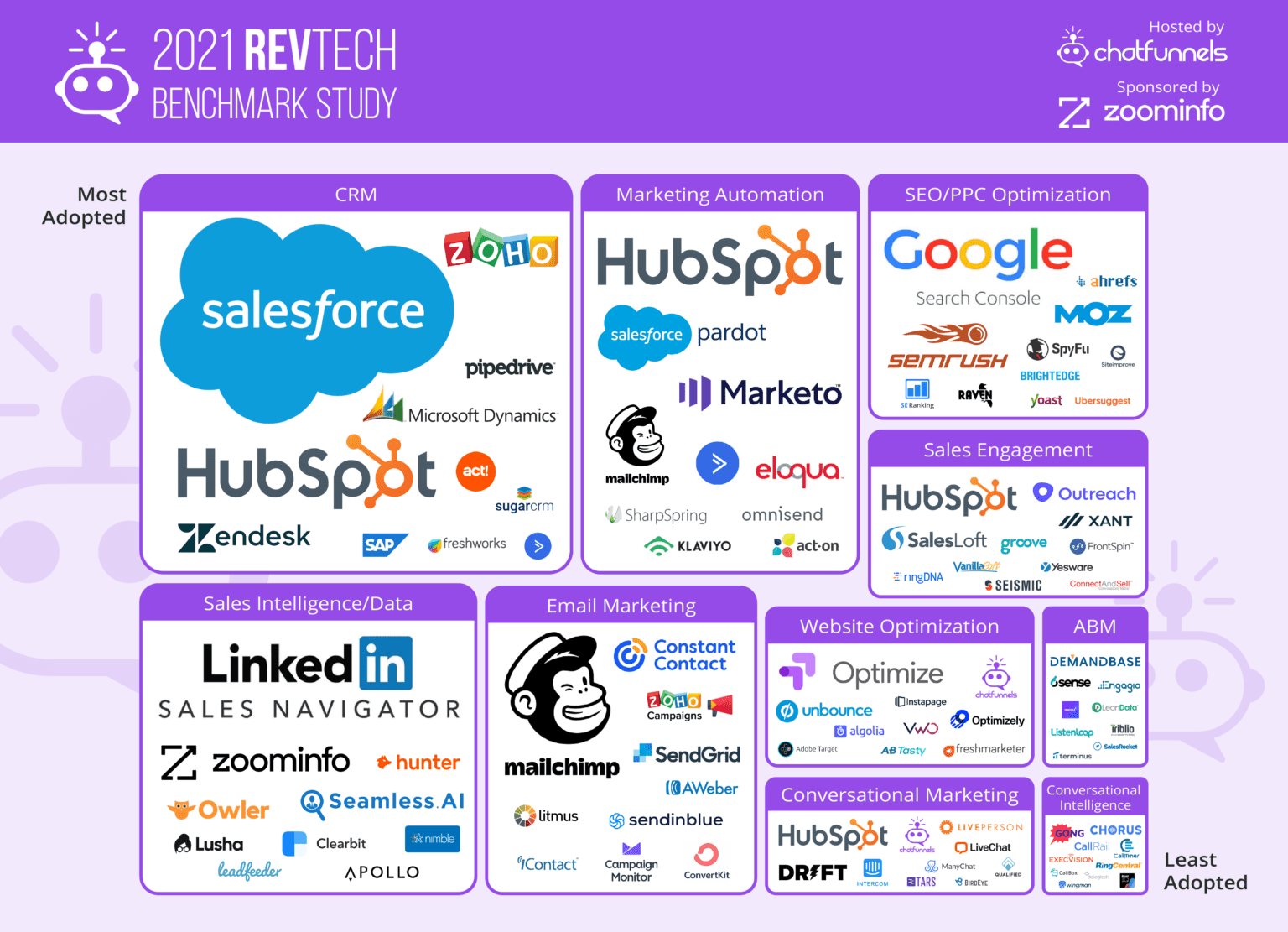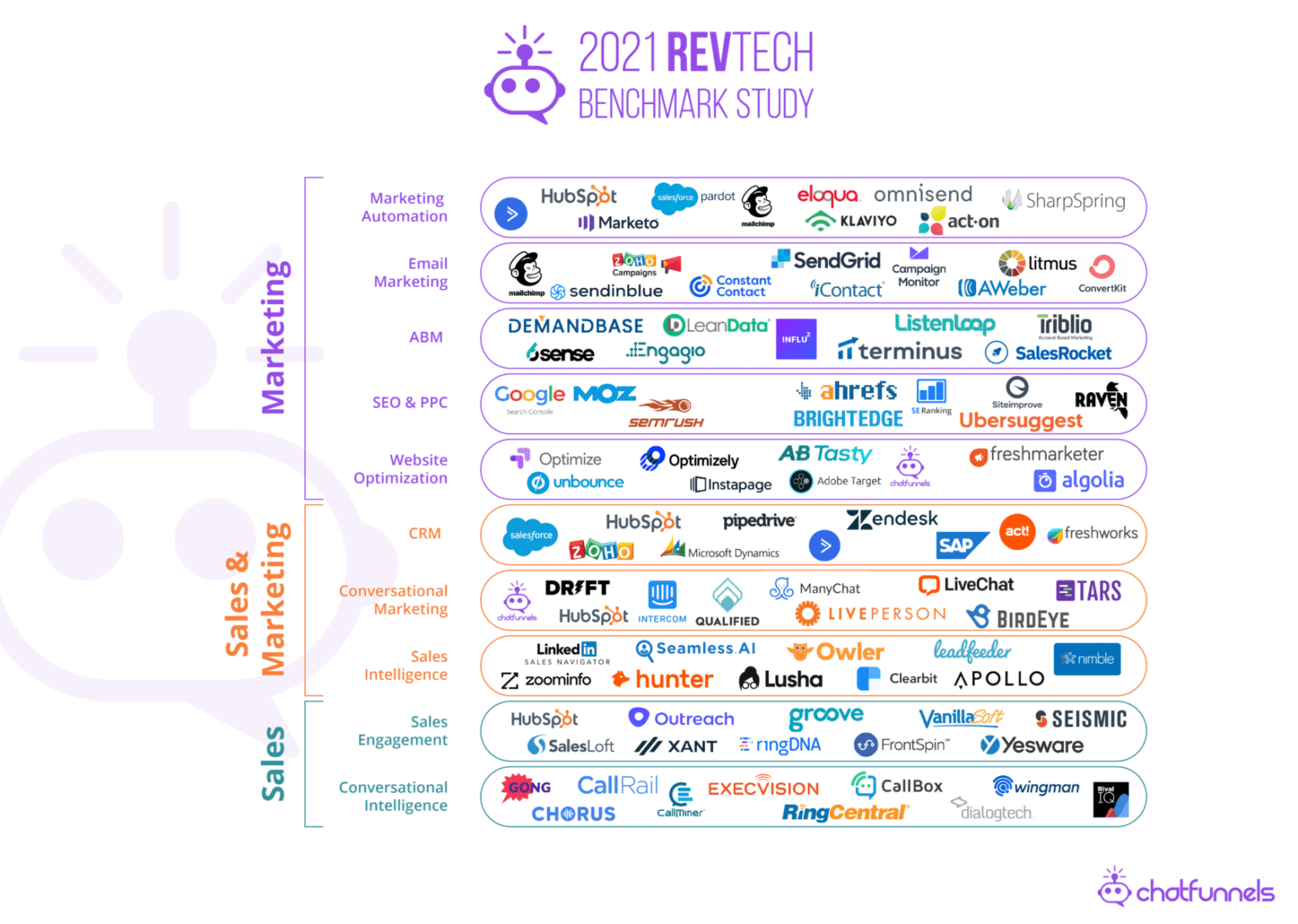RevTech 2021 Benchmark Study Market Map

We partnered with Dr. James Oldroyd, Associate Professor of Strategy at BYU, to conduct a survey on what technologies marketing and sales teams are adopting and using. 800+ people across the country completed the RevTech 2021 Benchmark Study and the results are comprised in the market map below.
A full explanation of the Benchmark Study was announced and reviewed at the RevTech Summit on January 27, 2021.
We wanted to find out the adoption rates not only of specific tools, but more so across broader categories of marketing and sales technologies. The following market map shows the top ten most adopted tools for the following ten categories.

In a list from most to least adopted tool, here are the results:
- CRM
- Sales Intelligence
- Marketing Automation
- Email Marketing
- SEO/PPC optimization
- Website Automation
- Sales Engagement
- Conversational Marketing
- ABM
- Conversational Intelligence
Consider this:
Sales intelligence tools and CRM’s have been around the longest. On the other hand, conversational marketing and conversational intelligence tools are the newest. In conclusion, people are more hesitant to adopt new types of technologies.
Here’s another map to showcase the findings of the study. This one is broken up into three major categories: marketing, sales and marketing, and sales. And it shows the individual categories based off which team’s budget pays for what types of technologies.

Other Notable Observations
- Salesforce continues to dominate the market for large and mid-sized companies. This really isn’t surprising for any of us. Chances are, most of us reading this have adopted Salesforce at our companies; it is the leading CRM.
- Hubspot owns the small company segment.
- Companies in the Pacific West region use more technology than any other region. And the other regions were a significant step behind.
- E-commerce and technology-focused companies adopt more technologies than any other industry segments.
- Companies seem to prefer single vendor technology platform vs. best-in-class multi-vendor approach.
- Companies seem to prefer using vendors that have similar market adoption rates to the other vendors they use.
- Moreover, vendors have higher adoption rates in regions near or adjacent to their headquarters.
- Large organizations are more likely to implement ABM solutions; smaller companies are more likely to implement email marketing solutions.
- Surprisingly, a new industry within marketing/sales technology has an adoption lifecycle of 20 years to reach 90% usage.
Best Practices
- If you’re not using a CRM, start using one! Companies without a CRM are definitely behind the curve. According to our study, the current adoption rate of CRMs is 89.31%. This shows that most people have figured out that CRMs are the key to success. You need a CRM in order to organize and stay on top of your customer relations. They help you track the status of prospects and manage your leads. Without a CRM, it is difficult to categorize leads and create opportunities. They provide information on sourcing, intent, and activity.
- Adopt a Marketing Automation technology. Their current adoption rate is 72%. The market mostly uses Hubspot, Pardot, and Marketo. Marketing Automation tools save you time and effort. In other words, it’s a way for marketers to seamlessly attract visitors and lead them to conversion.
- To get a leg up on your competition, consider investing in website optimization, conversational marketing, ABM, or conversational intelligence tools. These are currently the least adopted tools, since they are the newest technologies. And as we’ve seen from the study, there’s about a 20 year adoption lifecycle to reach 90% usage on any one of these technologies. These categories haven’t made it to that 20 year mark yet, which explains why their adoption rates are low. In short, you can easily get ahead of the curve by implementing one of the lower adopted tools.
Click here to download the Benchmark Study Market Map and learn more about the results from the study.
